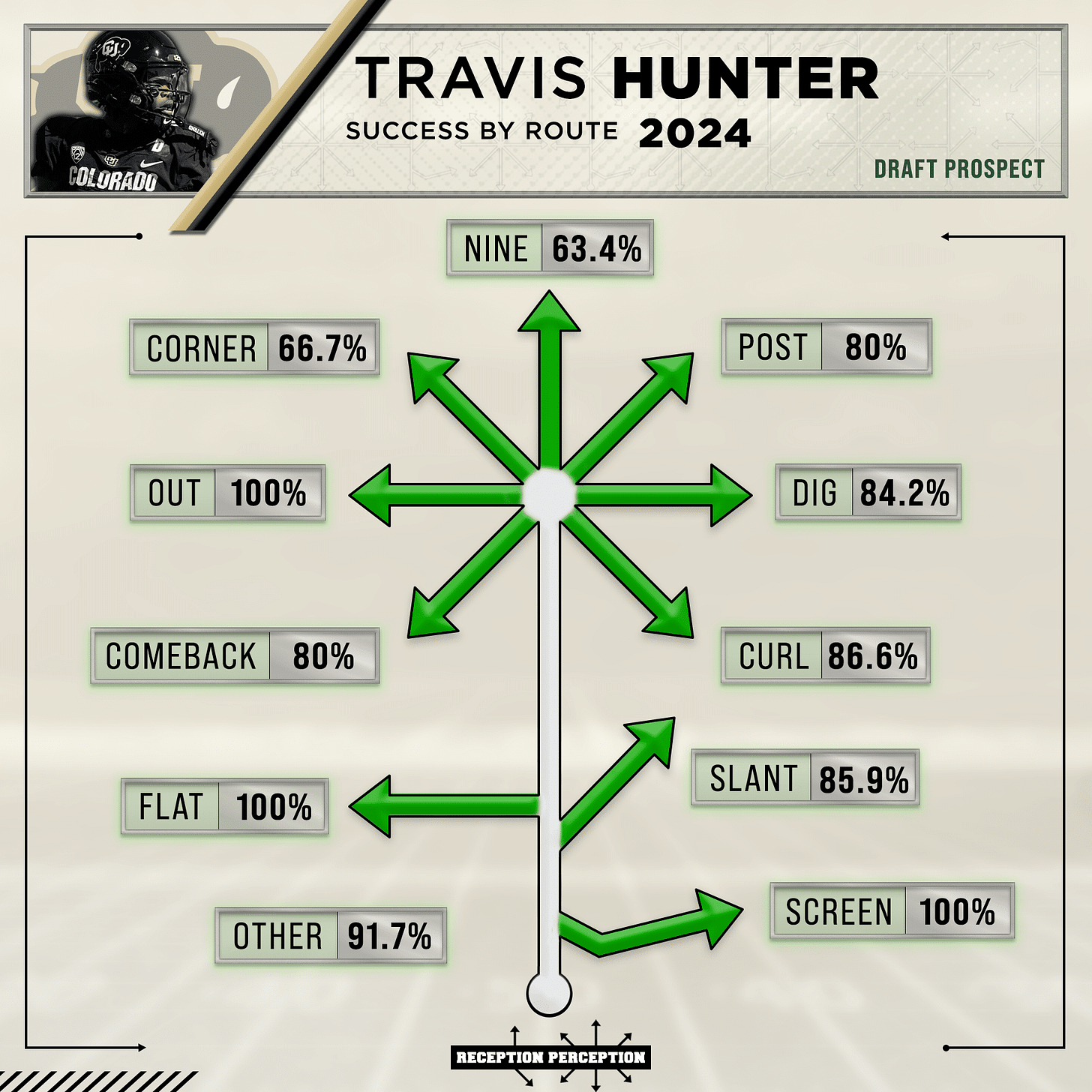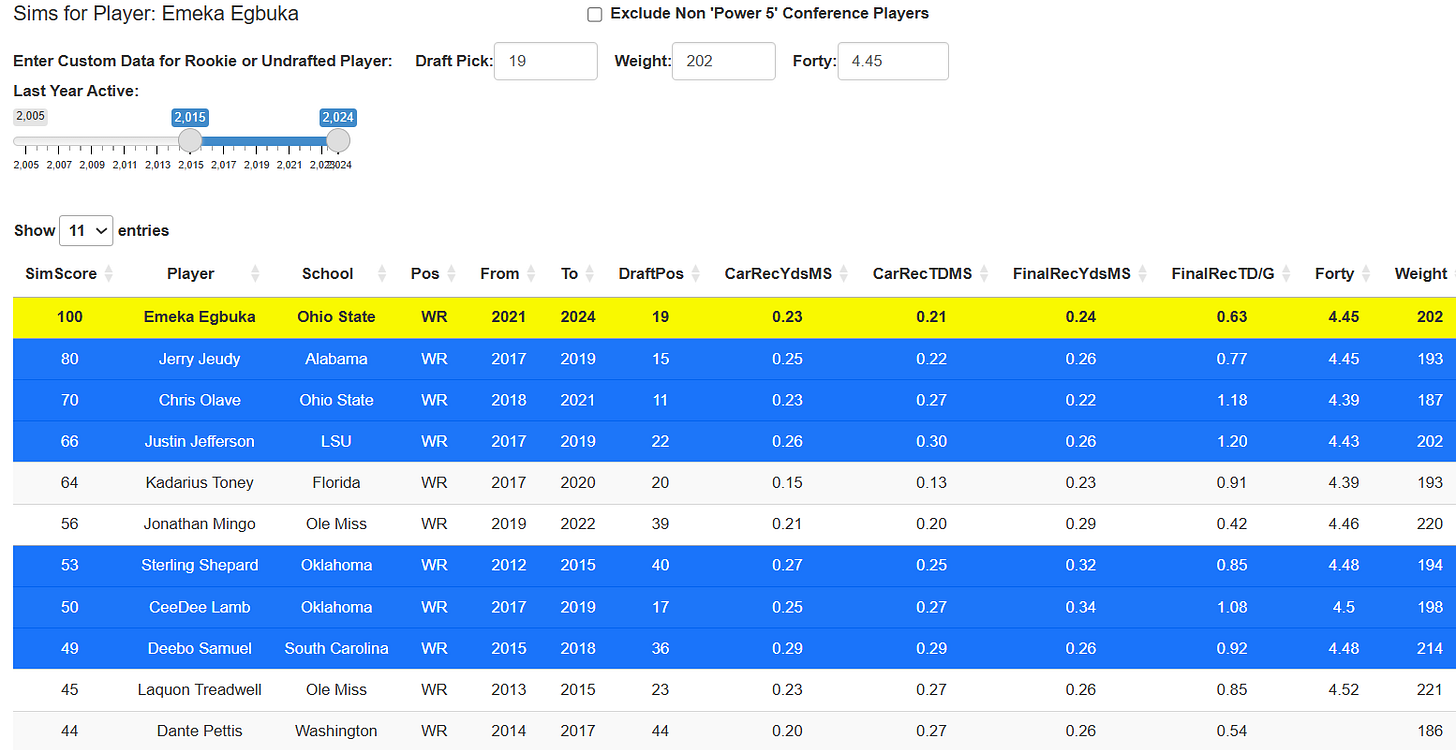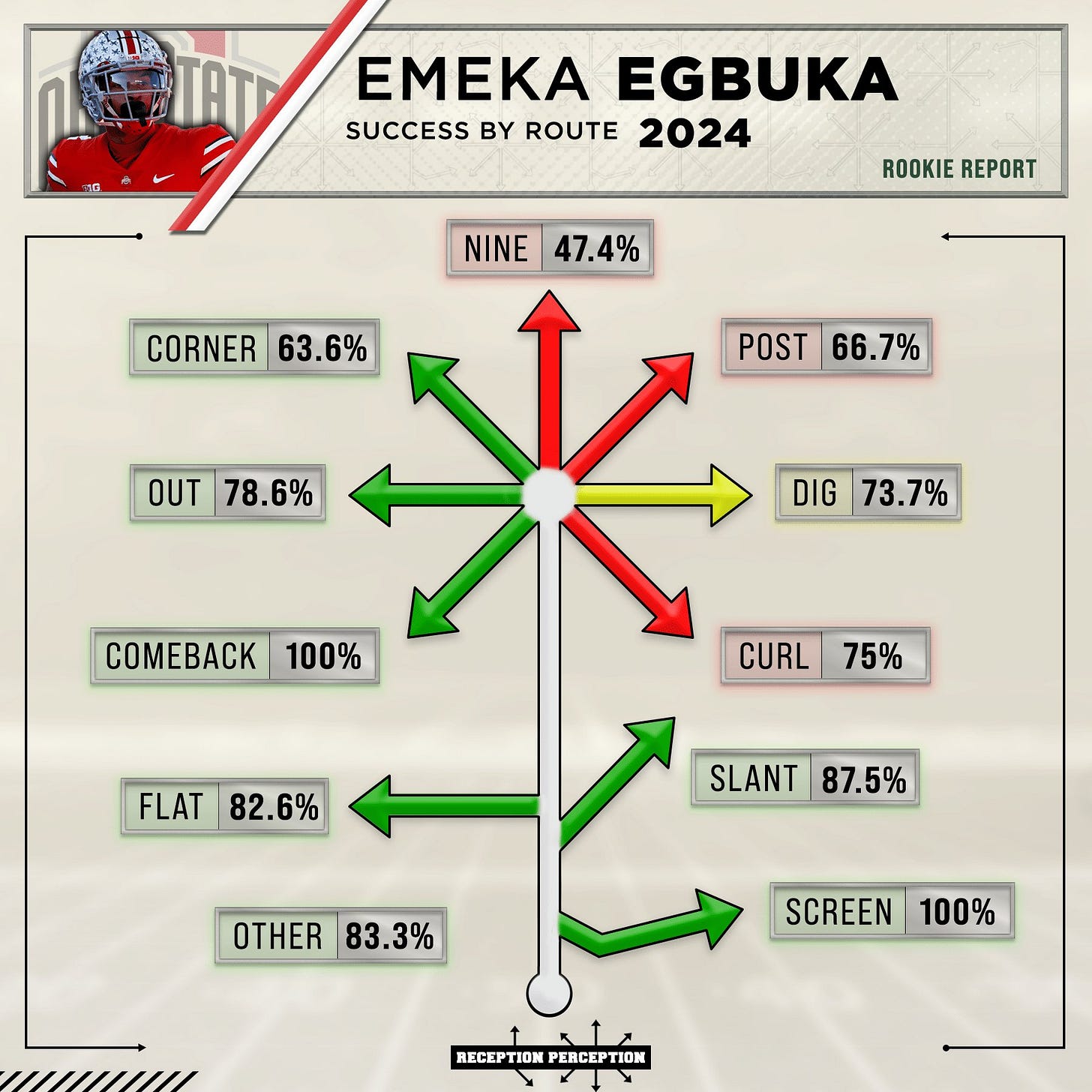Before the NFL draft, I don’t take many strong stands on the prospects during pre-NFL draft contests, as draft capital and landing spot are critical pieces of information for best ball. However, after the draft, when draft capital and landing spot are known, I dive in. Two of my favorite tools for are the Rotoviz Box Score Scout (BoSS) and Matt Harmon’s Reception Perception.
The BoSS takes a player’s measurables and production into account and compares it to other prospects going back nearly 20 years to generate a list of most similar players, like we see with Jayden Higgins here.
As a quantitative analytical tool, the BoSS is one of the best at providing a range of outcomes for the prospect, with the SimScore on the far left helping us to estimate how likely he is to perform similar to his comps.
Meanwhile, Harmon’s Reception Perception has proven to "provide “significant signal in how well a wide receiver gets open overall and especially against man coverage.” Reception Perception quantifies a player’s route running skills, compares them to a database of charted players, and provides insight into a player’s skillset.
Coupled together, these two tools present a Full Profile of a prospect.
Now, as ADP settles, I’ve analyzed the rookie receivers using these tools, reviewed my current exposure through 250 drafts, and reviewed my target exposure by the start of the season. I expect this will be valuable to those of us who’ve been drafting, as well as those of you just returning (here’s to the July 1 boys of my hometown league).
Today, we’ll cover the round 1 receivers, followed by the round 2 and later receivers in a follow-on post.
Round 1: Travis Hunter, Tet McMillan, Emeka Egbuka, Matt Golden
Travis Hunter (1.02)
Hunter is a unicorn, with his highest SimScore at only 30, which should not surprise us given he played both receiver and cornerback. However, he has a slew of elite comps, highlighted in blue in his BoSS below.
Meanwhile, his low-end comps include some busts, but all have a SimScore of less than 10, which is a very weak correlation. Ultimately, the BoSS presents Hunter as an extremely unique case with a wide range of outcomes, and it has low confidence in any prediction it makes. So, I want to rely more heavily on Hunter’s Reception Perception grading, which is below.
Hunter posted an all-green route tree, delivering a 92nd percentile success rate vs. man, a 97th percentile success rate vs. zone, and a 97th percentile success rate vs. press, leading Harmon to call him an elite wide receiver prospect.
Between Hunter’s BoSS and Reception Perception, he profiles as an elite prospect, even if his unique role reduces our confidence, which is reflected by the market.
Despite Hunter’s projection as an elite prospect, his ADP is at the 4/5 turn, because of playing time concerns. If we knew Hunter was going to play the majority of his snaps at receiver, he would likely be drafted nearly two rounds higher. A year ago, we took his most comparable BoSS prospect, Malik Nabers, in the late second round (who smashed that ADP). Using ETR’s draft capital, at Hunter’s current ADP of 49, we’re roughly de-valuing him by 25% compared to 2024 Nabers. While I understand the market’s hesitation, and Hunter certainly has one of the widest range of outcomes of any player in this range, his ceiling is sky high. In top-heavy best ball tournaments, that require us to finish first or second to advance, followed by a gauntlet of single weeks, Hunter is a bet I want to make at this ADP.
June 30 ADP: 49.2
Current Exposure: 11%
Target Exposure: 16-20%
Tet McMillan (1.08)
McMillan profiles as a X receiver from his BoSS, with his most comparable prospect Drake London. He also has a slew of other favorable comps, including CeeDee Lamb, Brandon Aiyuk, and Malik Nabers. His bust risk is illustrated with the string of failed X receivers that produced in college but struggled to separate in the NFL, including Treylon Burks, N’Keal Harry, and Quentin Johnston. Because of his archetype, I want to lean heavily into this Reception Perception profile to learn how much he needs to develop his route running to operate as a true X receiver in the NFL.
McMillan was a solid route runner, generating a 59th percentile score vs man, 60th vs zone, and 80th vs. press, and doing his best work on intermediate routes. However, his separation scores aren’t quite at the same level of Drake London, a comparison which Harmon slightly shies away from. Still, Harmon isn’t as bearish as the low-end BoSS sims, offering a more intermediate level X receiver comp in Michael Pittman, who notably lacks some of the vertical separation skills that McMillan also struggles with. Ultimately, McMillan is probably slightly overpriced from both a median and ceiling standpoint, though he walks into a situation where he could consolidate volume like a true #1 WR early, and develop into better player down the stretch.
June 30 ADP: 39.3
Current Exposure: 10%
Target Exposure: 6-8%
Emeka Egbuka (1.19)
I’ve been interested in Egbuka throughout the offseason, as we’ve knocked him for a variety of things that have little to do with his actual profile. Within his BoSS, we see multiple high-end comps, including Justin Jefferson, which is interesting given that we knocked Jefferson for similar “slot-only + lack of ceiling reasons” when he was a prospect.1 Additionally, Egbuka’s other strongest comps are receivers that have won with route running in the NFL, including Chris Olave and Jerry Jeudy. The Deebo Samuel and CeeDee Lamb comps aren’t super strong at a 49/50 SimScores, but each has been an effective YAC player in the league, which might be a sign that Egbuka can succeed there as well. Let’s compare with his Reception Perception profile.
Egbuka’s profile is a weird one, finishing in the 42nd percentile vs man, 82nd vs zone, and 92nd vs press, along with a strong divergence between in-breaking and out-breaking routes. That divergence probably speaks to a lack of elite speed, but Egbuka opted out of most combine drills, making it hard to know for sure. Ultimately that athleticism piece is a key piece of missing information, as a low 4.4 would put him in range of his higher comps like Jefferson and Olave, while a high 4.4 would comp him more to Jeudy and Sterling Shepard. Based on his lack of high-end skills at beating man coverage, he’s probably closer to Jeudy/Shepard than Jefferson/Olave. Still, Egbuka is significantly discounted relative to his round one counterparts, as the market is unsure of his overall playing time and his role as Chris Godwin returns from injury, which continues to peak my interest.
June 30 ADP: 89.4
Current Exposure: 11%
Target Exposure: 12-15%2
Matthew Golden (1.23)
Golden was a tough prospect for me to get on board with early, as his production was weaker than almost all of his high-end comps3, which I value more highly than elite athleticism. However, his QB play at Texas was also weaker than most of those players, meaning his relative production weakness is probably not entirely his fault. Additionally, Golden’s Reception Perception points to some upside.
Golden’s chart is visually appealing, with the all-green vertical routes, but he didn’t rank quite as well, finishing in the 44th percentile vs man, 77th vs zone, and 50th vs press. This type of extremely fast, vertical zone-beating receiver is a profile I’ve been skeptical of, as guys like Marquise Brown and Xavier Worthy have often failed to meet our fantasy expectations. Ultimately, I fall similar to both Harmon and the BoSS’ expectations, which is that Golden probably isn’t a true #1 WR in the NFL, but is a high-end #2 capable of delivering big plays on a variety of deep and intermediate routes. I also love his landing spot, as the Packers are poised to throw more and have a quality quarterback, offensive line, and playcaller. They also have an opening in the exact role Golden is likely to fill, with Doubs operating as the X, Jayden Reed racking up short/YAC opportunities in the slot, enabling Golden to feast on intermediate and deep routes. As a mid-7th round pick priced after receivers with a similar skillset (Addison, Jeudy, Olave) on a team I’m very high on, I’m in on Golden in best ball.
June 30 ADP: 76.8
Current Exposure: 15%
Target Exposure: 15%
Stayed tuned for a similar look at the round two and later receivers in a coming post!
Unfortunately, Harmon wasn’t charting prospects when Jefferson came out, as that would be one of the key comparisons to look at.
I had Egbuka at a target exposure of 15% in early June, but based on my further analysis and his slightly increased price, I’ve reduced that down to 12-15%.
And Ladd McConkey had a weird profile with limited playing time












